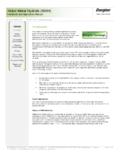Transcription of OxyChem Caustic Potash Handbook
1 1 of 40 Table of ContentsPage Introduction ..2 Principal Uses of Caustic Potash ..3 Manufacturing Process ..3 Forms of Caustic Methods of Shipping Liquid Caustic Potash ..6 Safety in Handling Caustic Unloading Liquid Caustic Potash from Tank Cars ..9 Unloading Liquid Caustic Potash from Tank Trucks ..13 Materials of Construction ..16 Technical Data SectionTables 1-7 ..22 How to Dilute/Strengthen Caustic Potash ..29 Methods of Analysis ..31 OxyChemCaustic PotashHandbookCAUSTIC POTASHHANDBOOKOxyChem KOHKOHAAAAAAAAAAAAAAAAAAAAAAAAAAAAAAAAAA AAAAAAAAAAAAAAAAAAAAAAAAAAAAAAAAAAAAAAAA AAAAAAAAAAAAAAAAAAAAAAAAAAAAAAAAAAAAAAAA AAAAAAAAAAAAAAAAAAAAAAAAAAAAAAAAAAAAAAAA AAAAAAAAAAAAAAAAAAAAAAAAAAAAAAAAAAAAAAAA AAAAAAATHE INFORMATION PRESENTED HEREIN WAS PREPARED BY TECHNICAL PERSONNEL AND IS TRUE AND ACCURATE TO THE BEST OF OURKNOWLEDGE.
2 OxyChem DOES NOT MAKE ANY WARRANTY OF MERCHANTABILITY OR FITNESS FOR A PARTICULAR PURPOSE, EXPRESS ORIMPLIED, REGARDING PERFORMANCE, STABILITY OR ANY OTHER INFORMATION CONTAINED HEREIN IS NOT TO BECONSTRUED AS AN EXPRESS WARRANTY CONCERNING THE PERFORMANCE, STABILITY OR ANY OTHER CHARACTERISTIC OF ANY OXYCHEMPRODUCT. THIS INFORMATION IS NOT INTENDED TO BE ALL-INCLUSIVE AS TO MANNER OR CONDITIONS OF USE. HANDLING, STORAGE, DIS-POSAL AND OTHER ACTIVITIES MAY INVOLVE OTHER OR ADDITIONAL LEGAL, SAFETY OR PERFORMANCE CONSIDERATIONS. WHILE OURTECHNICAL PERSONNEL WILL RESPOND TO ANY QUESTIONS REGARDING SAFE HANDLING AND USE PROCEDURES, SAFE HANDLING ANDUSE REMAINS THE RESPONSIBILITY OF THE CUSTOMER.
3 NO SUGGESTIONS FOR USE ARE INTENDED AS, AND NOTHING HEREIN SHALL BECONSTRUED AS A RECOMMENDATION TO INFRINGE ANY EXISTING PATENT OR TO VIOLATE ANY FEDERAL, STATE OR LOCAL Chemical Corporation 2000 ForwardThis Handbook details methods for handling,storing, preparing and using Caustic Potash . Itincludes information on the manufacture, physical properties and analytical methods for testing caus-tic information and contacts can be foundon the internet at Chemical CorporationBasic Chemicals GroupOccidental Tower5005 LBJ FreewayDallas, Texas 752442of 40 IntroductionCaustic Potash is manufacturedby the electrolysis of potassiumchloride brine in either a mercuryamalgam or membrane electrolyticcell.
4 The co-products are chlorineand largest users of causticpotash are the soap and detergent,fertilizer, and chemical uses for Caustic Potash aremolten salts, dyes, pharmaceuti-cals, and photographic Chemical Corporationhas played a leading role in provid-ing Caustic Potash to meet theincreasing demands of plants are located to con-veniently and economically serve allindustries. Warehouse stocks ofOxyChem Caustic Potash and otherproducts are maintained in principalcities.. Distributor stocks are alsoavailable in these and many othercities that form a network of supplyfor the end users 1994 Occidental Chemical Cor-poration became the first pro-ducer of membrane cell causticpotash at its Mobile, AL facility.
5 Thisprocess demonstrates the latest inchlor-alkali technology.*Acknowledgement is made of thecourtesy of the Sargent-Welch ScientificCompany, of Skokie, IL, in granting per-mission to reproduce in modified formthe potassium, oxygen, and hydrogenportions of the 1979 revised edition ofthe Periodic Chart of the Atoms. 3of 40 Principal Uses andConsumption ofCaustic PotashManufacturingProcessCaustic Potash is one of the veryfew chemicals finding almost uni-versal application. Some of the prin-cipal products or processes inwhich Caustic Potash is used, are: A dehydrating agent for drying gases A lubricant in the extrusion press-ing of high melting alloys A scavenger in a gasoline treatingprocess (dual layer)
6 For removingmercaptans A methylating agent An alkaline builder in detergentformulations In refining petroleum fractions In electrolytic stripping baths In chemical compounding In a molten bath for removingpolyesters and polyurethanes fromsteel objects In an absorption cartridge forscavenging carbon dioxide As a chemical desiccant As a cleaner for eliminating scalefrom the surface of titanium alloyintermediates As an agent for lowering the sulfurcontent of coal In alkaline batteries In removing insulating coatingsfrom wire In purifying olefin feedstock con-taining hydrocarbons prior to poly-merization In stabilizing synthetic lubricants In removing napthenic acids fromgas oils In fertilizers In descaling ferrous metals In sweetening sour petroleumfractions In a fused alkaline salt mixtureused for metal cleaning In lye peelingCaustic Potash is produced com-mercially by an electrolytic processas shown in the flow diagram on thefollowing page.
7 Brine, preparedfrom potassium chloride, is elec-trolyzed in either a mercury cell or amembrane co-products arechlorine and the mercury cell process, apotassium-mercury amalgam isformed in the cell. The amalgam issent to the decomposer where it isreacted with water to form liquidKOH, hydrogen and free free mercury is returned to theelectrolytic cell. The resulting caus-tic Potash solution is either invento-ried in storage tanks as 45% or50% solutions or concentrated byevaporation to a 90% anhydrousform. The liquid is shipped in tanktrucks, tank cars, barges or anhydrous forms are briquette,flake and crystal. These forms areshipped in drums, bags or mini bulkbagsIn the membrane process, a solu-tion of approximately 30% instrength is formed.
8 This solution isthen sent to evaporators which con-centrate it to a strength of 45% or50% by removing the appropriateamount of water. The resultingcaustic Potash solution is invento-ried in storage tanks prior to 40 Flow Diagram ofManufacturingKCl + H2O = Brine Brine TreatmentMercury CellChlorineElectricityMembrane CellHydrogenChlorine28-32% liq. KOHH2O Evaporators 45 or 50% liq. KOHD ecomposersH2 OHydrogenConcentratorDehydratorAnh. KOH(Flake, Crystal or Briquette)45% liq. KOH50% liq. KOHTank TrucksTank CarsBarge or ShipDrumsBagsBulk Bags5of 40 Forms of Caustic PotashLiquid Caustic Potash is availablein two concentrations, 45% and50% and in four grades, Commer-cial, Membrane, Industrial and Caustic Potash is mar-keted in three forms, briquette, flakeand crystal.
9 Drum packages includesizes of 100, 400 and 450 of the three forms is availableas a special order in 2000 poundbulk bags. Also, the flake form isavailable in 50 pound (DRY) FORMBRIQUETTELIQUIDFLAKECRYSTAL6of 40 Methods of Shipping Liquid Caustic PotashLIQUIDL iquid Caustic Potash is availablefrom OxyChem s plants and termi-nals in tank truck, tank car, barge orship quantities. Each form of trans-portation has advantages. The typeof service selected will depend onsuch factors as size and location ofstorage, rate of consumption, plantlocation, freight rates, etc. Oxy-Chem s Technical Service staff cansurvey your present facilities andrecommend the most economicalmethod of transportation for Potash , liquid and dry, isregulated by the Departmentof Transportation (DOT) and is clas-sified as a Corrosive DOT number is UN1814for liquid and UN1813 for dry.
10 Bothliquid and anhydrous are HazardClass 8 and Packing Group 40 Safety in Handling Caustic PotashCaustic Potash in any form mustbe respected by everyone whohandles and uses it. Beforestarting to work with it, the usershould be aware of its proper-ties, know what safety precau-tions to follow, and know how toact in case of contact. Acciden-tal exposure to Caustic potashmay occur under several condi-tions. Potentially hazardous situ-ations include handling andpackaging operations, equip-ment cleaning and repair, decon-tamination following spills andequipment failures. Employeeswho may be subject to suchexposure must be provided withproper personal protectiveequipment and trained in its general guidelines follow.






